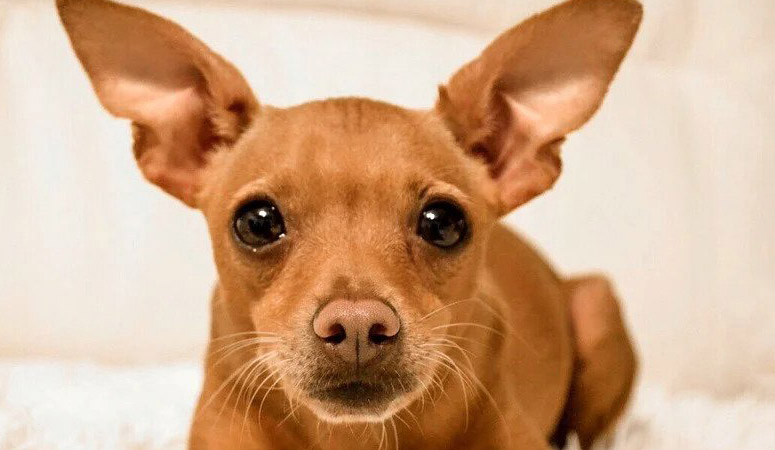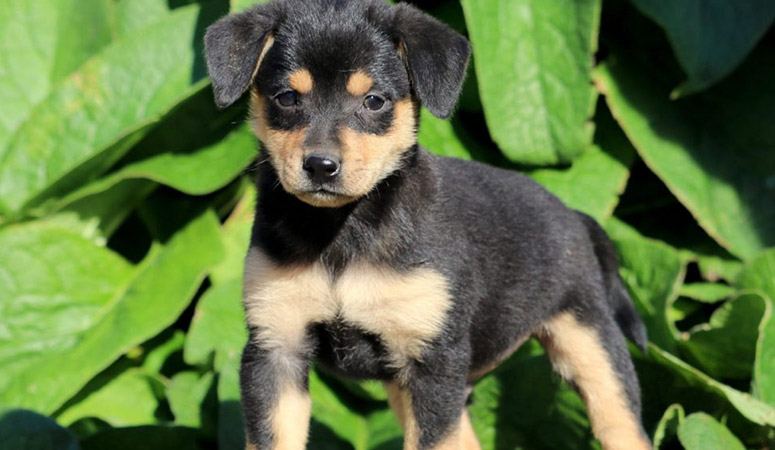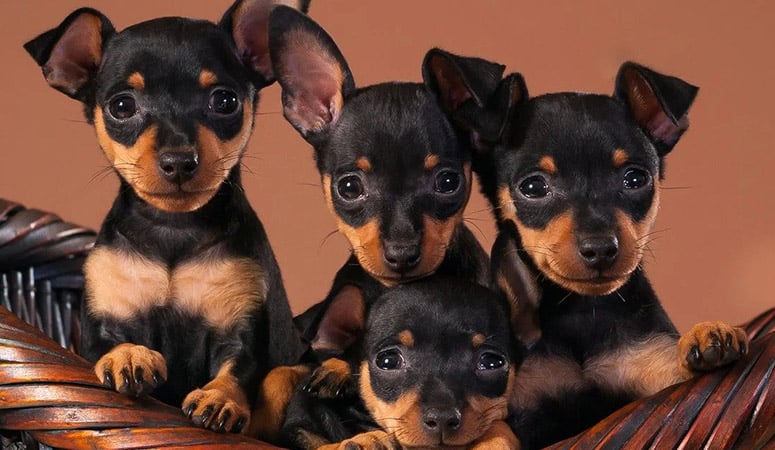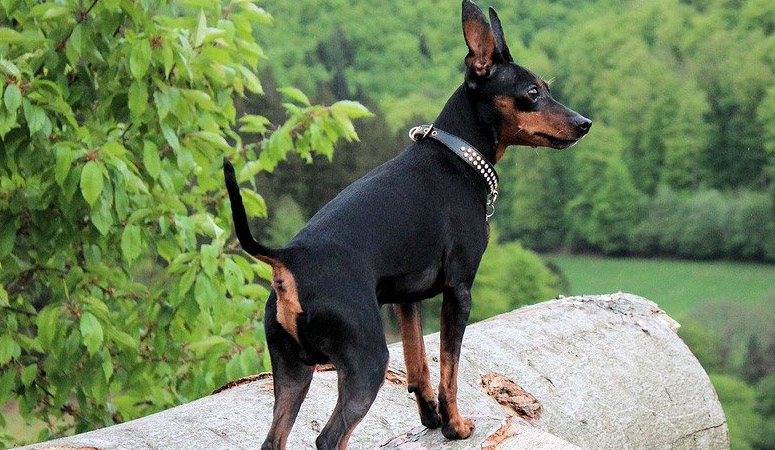Miniature Pinscher
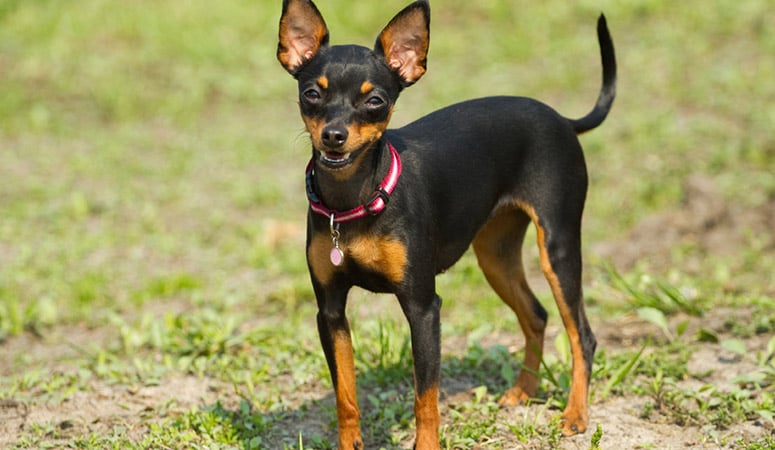
Originally bred in Germany to hunt vermin, primarily rats, the Miniature Pinscher is known as the “King of Toys.” With small size, compact, wedge-shaped body and lustrous coat, the breed was brought out high-stepping “hackney” gait and self-possessed, “big dog” personality.
| Other Names | Min Pin, Zwergpinscher |
| Color | Black & Rust, Black & Tan, Chocolate & Rust, Chocolate & Tan, Red, Stag Red |
| Height | Males: 10-13 inches. Females: 10-13 inches. |
| Weight | Males: 9-13 pounds. Females: 9-13 pounds. |
| Life Span | 12-16 years |
| Personality | Fearless, Fun-Loving, Proud |
| Exercise | Regular Exercise |
| Origin |
| Popularity | #74 |
| Groom Needs | Occasional Bath/Brush |
| Kids Friendly | No |
| Dog Friendly | Yes with supervision |
| Watch Dog | |
| Family Dog | |
| Litter Size | 2~6 |
Miniature Pinscher Pictures
Miniature Pinscher Video
Introduction
Lots of people think of this little pooch, the Miniature Pinscher as just a little mini Doberman – they almost look exactly the same, right? But that’s not true – however; Miniature Pinschers and Doberman Pinschers are both related to German Pinschers. Miniature Pinschers are pretty spunky and cute – being classified as part of the Toy breed of dogs. His height is about 12.5 inches at the shoulders and he weighs about 10 pounds. Their ears stand erect if cropped and they have small little feet that are similar to a cat! His tail is short and erect, with a short, smooth coat, usually black and tan in color, but which can include red, stag red, black with rust, chocolate with rust, and chocolate with tan. They are brave and fearless little dogs and good with children, with super intelligence. They’re small but have bold, assertive personalities – everyone will know if there is an intruder around. His high-pitched, noisy bark is better than any alarm! Provide them with chew toys to keep them busy. He is very energetic so he needs plenty of exercise. They’re often affectionately referred to as min-pins, and their big, sparkly personalities have also earned them the title of “King of Toys”. Other names for them are the Zwerg or the Dwarf Pinscher.
Living with Miniature Pinscher
With short, smooth coat, Min Pins are really easy to groom and they do not require much grooming. With a new puppy, you should spend time together in grooming sessions to help him get used to being worked with, which is an opportunity to develop the bond between you.
Their small size means that there is less fur shed than from a larger dog with the same kind of short coat. A bristle brush once or twice a week is sufficient.
Bathe the Min Pin with the gentle dog shampoos available as you desire or only when he gets dirty. Too-frequent baths can cause skin irritation, so they should not be bathed excessively.
Trimming nails regularly will help avoid painful splitting, cracking, or breaking a nail.
Just like other Toy breeds, dental issues are common. So brush your Min Pin’s teeth daily with vet-approved pet toothpaste and take them to your veterinarian regularly.
Miniature Pinschers need plenty of exercise to meet their abundant level of energy because they like comfortable lifestyle, which will make them wonderful companions.
Enough daily exercise can help ameliorate the Min Pin’s challenging behaviors, excessive barking, and destructiveness. The Miniature Pinscher will benefit from walks and jogs with his human every day outdoors as well, which can help ensure his optimum mental and physical health.
The breed requires time outdoors to burn off their excessive energy, but they cannot be trusted outside alone, so a leash or fenced yard may be necessary. The Min Pin is sensitive to cold weather, and jackets and booties may be needed in cold climates.
High-quality dry dog food whether commercially manufactured or home-prepared with your veterinarian’s supervision and approval is required to feed your Miniature Pinscher and meet his nutrition needs. The general amount of the food is a half cup to one cup per day, split between two or three meals, but the amount should vary with dog’s size, activity level, metabolism and age.
While Miniature Pinschers may be territorial, they do not tend to guard their food more than any other breed. Children should never be allowed to touch or remove food from any dog while it is eating.
Watch your dog’s calorie consumption and weight level to keep it from getting overweight.
Clean, fresh water should be available at all times.
A responsible breeder should learn about which human foods are safe for dogs, and which are not. And if there are any concerns about your dog’s weight or diet, check with your vet.
In general, Min Pins are healthy and they’re prone to certain health conditions, such as legg-calve-perthes disease, epilepsy, hypothyroidism, progressive retinal atrophy (PRA), heart concerns, and knee and joint concerns, etc. Not all Min Pins will suffer from any or all of these diseases, but it’s important to be aware of them if you’re considering this breed.
Responsible breeders will take their stock to test for health conditions regularly, such as patella evaluation. The Min Pin is prone to obesity if not regularly exercised and is particularly sensitive to cold temperatures.
Brush The MInPin’s teeth with a toothpaste designed for dogs can help keep the dog’s dental health and prevent some oral diseases.
With an average life expectancy of 12-16 years, you should make sure the regular visits to the vet for checkups and parasite control help to ensure your dog has a long, healthy life.
Total Annual Cost: $2647.2
Cost is estimated for the first year and may vary depending on many factors, such as dog food, health care, leash, collar, licensing, possible fencing, crates, training and obedience classes, dog-walking, grooming, treats, toys, flea, tick, and heart-worm meds, microchips, etc.
Socialization with other people, children, and dogs from young age is required to keep the Min Pin from becoming timid or quarrelsome and can help ensure that your Min Pin puppy grows up to be a well-rounded dog.
Smart and affectionate towards their families, they are independent and may try to test their owner’s limits. So obedience training is a good idea, but its stubborn streak may make it harder to be done.
They enjoy spending as much time as possible with their family and prefer a lap to a dog bed and. The Min Pin might be suitable for apartment living, but he still needs training not to bark unless necessary—which may be futile.
Known to outsmart their owners, they often attempt to establish top-dog status in the household. And a firm, yet gentle, training technique will work best. Advanced tricks may be a fun way to help Min Pins burn excess energy and get the mental stimulation they need to be content.
Leash training and a solid recall are also high-priority skills to teach to this escape artist and they may be slow to housebreak. They are also good candidates for agility or advanced obedience training.
History
The Min-Pin is said to be centuries old, but some factual evidence shows they have been around for only about 200 years. They originate from Germany.
They have been developed from cross the German Pinscher, the Dachshund, and the Italian Greyhound together.
In early times, the Miniature Pinscher’s job was to eradicate rodents from stables and barns.
They started off at the American Kennel Club in 1925 and were registered in the Terrier Group but were moved to the Toy Group in 1930, becoming known as Miniature Pinschers in 1972. The Miniature Pinscher is not a miniature Doberman pinscher at all. Although they share the same homeland of Germany, the relationship stops there.
During the early days of dog shows, breeders almost ruined the Miniature Pinscher by breeding to get the small size at the expense of other criteria. Fortunately, by 1900, breeders had corrected their direction and the Miniature Pinscher has never looked back.
Because of its elegance and showmanship, the breed soared to new heights as a show dog in pre-World War I Germany and has continued to flourish as a show dog and companion throughout the world since.
Helpful Information
Breed Club: MINIATURE PINSCHER CLUB OF AMERICA, INC.
Breed Club Link: http://www.minpin.org/
Breed Club Rescue: MPCA RESCUE
Breed Club Rescue Link: http://www.minpin.org/?page_id=23821

